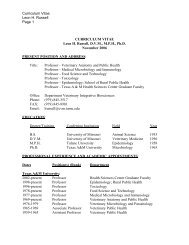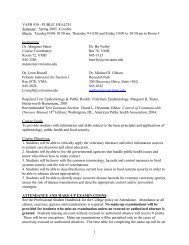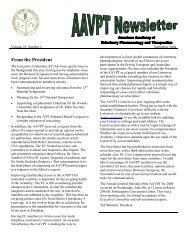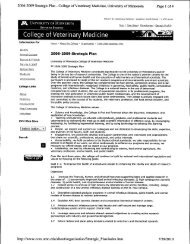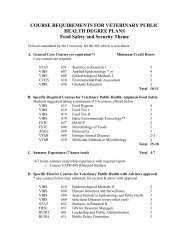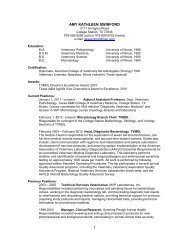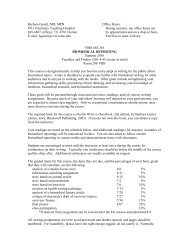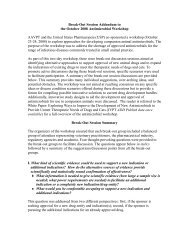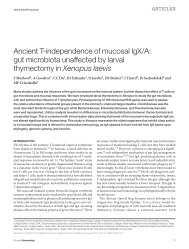Disaster - College of Veterinary Medicine - Texas A&M University
Disaster - College of Veterinary Medicine - Texas A&M University
Disaster - College of Veterinary Medicine - Texas A&M University
You also want an ePaper? Increase the reach of your titles
YUMPU automatically turns print PDFs into web optimized ePapers that Google loves.
Research<br />
Spotlight<br />
From drug delivery systems to cosmetics, the science <strong>of</strong><br />
nanotechnology has a wide range <strong>of</strong> applications. This science<br />
is based on the unusual properties that materials exhibit when<br />
their dimensions are reduced to the nanoscale, that is, to less<br />
than 100 nanometers (which is 1000 times smaller than the width<br />
<strong>of</strong> a human hair). For example, while inert at normal scales,<br />
gold nanoparticles are catalytically active and are being used to<br />
improve the performance <strong>of</strong> fuel cells. Further, unlike its bulk<br />
form, zinc oxide nanoparticles have better UV blocking properties,<br />
making them ideal for use in sunscreens.<br />
While the unique properties <strong>of</strong> nanoparticles are being<br />
exploited to generate a range <strong>of</strong> products, questions about the<br />
potential toxicity <strong>of</strong> these particles have not been adequately<br />
addressed. For example, how do nanoparticles incorporated<br />
into food matrices to increase longevity and freshness affect the<br />
immune system? How does inhaling an aerosolized mixture <strong>of</strong><br />
nanoparticles affect the lungs?<br />
Such questions are the focus <strong>of</strong> Dr. Christie Sayes’ research<br />
at the <strong>Texas</strong> A&M <strong>University</strong> <strong>College</strong> <strong>of</strong> <strong>Veterinary</strong> <strong>Medicine</strong> &<br />
Biomedical Sciences. Sayes, an assistant pr<strong>of</strong>essor in the department<br />
<strong>of</strong> <strong>Veterinary</strong> Physiology & Pharmacology, and her research<br />
group are at the forefront <strong>of</strong> a relatively new and rapidly developing<br />
field—nanotoxicology.<br />
Toxicity studies<br />
The toxic effects <strong>of</strong> nanoparticles are attributed to their<br />
various physicochemical properties, for example, size, surface<br />
reactivity, optical and electronic properties, agglomeration state<br />
and composition.<br />
“Studies in my laboratory and in the labs I was trained in, as<br />
well as the experiences <strong>of</strong> our collaborators all over the world<br />
[have indicated] that nanoparticle exposure results in inflammatory<br />
responses [for example, through the generation <strong>of</strong> reactive<br />
oxygen species],” Sayes said.<br />
“We’ve seen membrane oxidation,<br />
protein oxidation and even<br />
DNA oxidation.”<br />
In a previous study, Sayes<br />
showed that at high concentrations,<br />
nanoscale titanium<br />
dioxide particles, which are<br />
used in solar cells, for example,<br />
disrupted the normal activity <strong>of</strong><br />
human dermal fibroblasts and<br />
human lung epithelial cells in<br />
culture through oxidative dam-<br />
Top image: A human skin cell<br />
exposed to green quantum dots,<br />
which preferentially associate with<br />
the cell’s mitochondria.<br />
Bottom Image: A human skin cell<br />
exposed to green quantum dots<br />
encapsulated in polymer<br />
microcapsules. The red stain shows<br />
the healthy morphology <strong>of</strong> the cell<br />
by highlighting the cytoplasm.<br />
14 • CVM Today • Summer 2010<br />
Nanotoxicology:<br />
Exposing hidden dangers<br />
by Roma Subramanian<br />
age. Further, she has<br />
shown that depending<br />
on their surface<br />
reactivity, nanoquartz<br />
particles intratracheally<br />
instilled<br />
in rats produced<br />
different degrees <strong>of</strong><br />
pulmonary inflammation<br />
and cytotoxicity.<br />
These and other<br />
studies conducted<br />
by her lab on the<br />
biological effects <strong>of</strong><br />
different types <strong>of</strong><br />
nanoparticles have<br />
(From left to right) Michael Berg,<br />
helped provide evi-<br />
Aishwarya Sooresh, Dr. Christie Sayes,<br />
dence for nanopar- Nivedita Banerjee, and Amelia Romoser<br />
make up the research team studying<br />
ticle toxicity.<br />
nanoparticles.<br />
Currently, Sayes’<br />
lab is investigating the mechanisms underlying nanoparticleinduced<br />
inflammatory cascades and adverse immune responses.<br />
“Some <strong>of</strong> the cells in the body look at nanoparticles as antigens,<br />
and it’s the [resulting] increase in antibody production<br />
that’s really interesting,” Sayes said. “We know that antibodies<br />
are recruited, but do antibodies know to bind to nanoparticles to<br />
get rid <strong>of</strong> them? Can macrophages [cells involved in the body’s<br />
defense response] see nanoparticles and if not, will the particles<br />
persist in our body, or will we able to excrete them out?”<br />
The lab is also investigating the effect <strong>of</strong> a nanoparticle’s agglomeration<br />
state on cytotoxicity. Although nanocrystals, which<br />
can be in the form <strong>of</strong> a powder, tend to agglomerate in water,<br />
this agglomeration is not irreversible.<br />
“As nanoparticles move from one compartment <strong>of</strong> the body to<br />
another, they could de- and then reagglomerate,” Sayes said. “For<br />
example, when an agglomeration <strong>of</strong> nanoparticles gets immersed<br />
in lung surfactant fluid [secreted by lung alveolar cells], you<br />
sometimes immediately see a deagglomeration <strong>of</strong> particles, that<br />
is, the particles separate from each other.”<br />
Since cells appear to treat individual nanoparticles differently<br />
from the way they treat nanoparticle agglomerates, Sayes is interested<br />
in investigating the differential cellular uptake mechanisms<br />
<strong>of</strong> individual versus aggregated nanoparticles.<br />
Also, in collaboration with Swansea <strong>University</strong>, UK, Sayes’<br />
lab is investigating the toxicological effects <strong>of</strong> nanoparticles in<br />
composited materials. The project will examine whether in a car<br />
crash involving car bumpers made <strong>of</strong> nanomaterial composites,<br />
the nanoparticles embedded in the composited material are<br />
released and if so, whether they retain their physical and chemical<br />
characteristics and what would be the implications for the<br />
environment or human health.<br />
Challenges<br />
“The dose makes the poison,” is an <strong>of</strong>t repeated maxim in toxicology.<br />
However, the absence <strong>of</strong> a standardized unit to express




